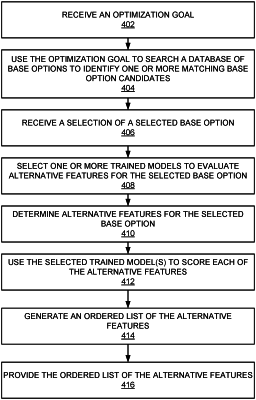| CPC G06N 20/00 (2019.01) [G06F 16/24578 (2019.01); G06F 16/9535 (2019.01); G06F 30/00 (2020.01); G06N 5/04 (2013.01); G06Q 10/04 (2013.01); G06Q 10/063 (2013.01); G06Q 10/067 (2013.01); G06Q 30/02 (2013.01); G06F 2113/12 (2020.01)] | 19 Claims |

|
1. A method for optimizing computer machine learning, comprising:
receiving an optimization goal;
selecting a base option that at least in part matches the optimization goal, wherein the base option is selected based in part on a divergence between actual performance that includes measured sales data of the base option and performance that includes expected sales data of the base option predicted by one or more machine learning prediction models, wherein the base option has a score above a threshold score, wherein the base option and one or more matching base option candidates are ranked based on their corresponding scores, wherein the one or more matching base option candidates are a pre-defined number of possible base options;
utilizing the one or more machine learning prediction models selected based at least in part on the optimization goal to determine prediction values associated with alternative features for the selected base option, wherein the one or more machine learning prediction models were trained using training data to at least identify machine learning weight values associated with the alternative features for the one or more machine learning prediction models;
based on the prediction values, sorting at least a portion of the alternative features to generate an ordered list of at least the portion of the alternative features for the selected base option; and
providing the ordered list for use in manufacturing an alternative version of the selected base option with one or more of the alternative features in the ordered list.
|